
 Copy URL to Clipboard
Copy URL to Clipboard
If you run a retail or eCommerce store, then you know that how retailers handle returns through reverse logistics is a huge part of the industry. In fact, according to the National Retail Federation, retailers report that 11% of holiday purchases get returned each year. Although the holidays are the busiest time, retail returns are an ongoing problem year-round, and if you aren’t prepared to deal with them, you could end up losing a considerable chunk of your revenue!
Retailer returns are managed through a process known as “reverse logistics.” Reverse logistics is a term broadly used to describe the movement of goods after the point of sale, but it also includes the storage of returned goods, returns processing, and value reclamation. By utilizing a strong reverse logistics strategy, you can manage returns quickly and maximize profits.
Table of Contents
When it comes to managing returns, there is no perfect way to do it. Every retailer is going to do it slightly differently depending on their products, policies, and other factors. Additionally, returns for eCommerce stores are going to be very different from physical stores.
Retailers that have both brick-and-mortar and online stores face even more difficulties as that requires managing returns in two different ways, and it opens up many more questions that need to be answered. For example, some stores allow online purchases to be returned in-store, while others don’t, and some products are only offered online and not in stores. Some companies even offer free return shipping, while others require customers to pay that.
There are many reasons why a customer could choose to return an item. The problem could be as simple as the color not being as bright as the customer thought, or maybe the item didn’t meet the customer’s needs. However, the problem could also be more severe, like faulty manufacturing or damage.
Regardless of the reason, the customer needs an easy way of getting rid of the unsatisfactory product. There are two common ways of returning a product: at the customer service desk in-store, or by sending it back in the mail. The reverse logistics process comes into play as soon as the product is out of the customer’s hands.
GET A QUOTE
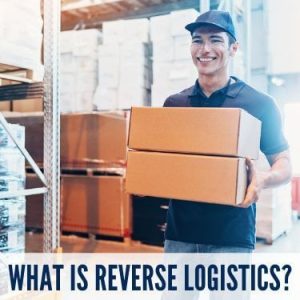
Reverse logistics is a process that is simple in theory, but difficult to manage in practice. In short, when a product is sent backward in the supply chain after a point of sale, like to the store, warehouse, or manufacturer, that is reverse logistics. Managing the products moving back in the supply chain can be chaos if it is not planned out properly, but it is a necessary part of doing business. If you sell anything, you can expect at some point to deal with product returns.
Most companies, whether online or not, have to deal with returns on a daily basis. Because of that, it is essential to maximize the efficiency of your reverse logistics operations. A streamlined process for managing returns can help you maximize profits and handle even large volumes of returns quickly. Having a solid strategy can give you a competitive edge; not having a good strategy, or not having one at all, can make you fall behind your competitors.
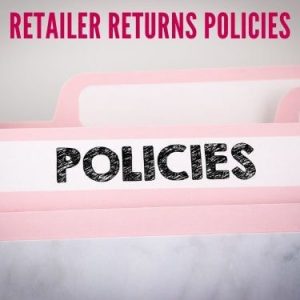
Although return policies can vary considerably between different retailers, there are some things that all policies have in common. There are three simple elements that make up the standard returns policy:
Additionally, eCommerce stores have a fourth requirement: The return shipping process.
The elements by themselves seem vague now, but when put in practice, it starts to make sense. To get a better understanding of how these elements are present in varying policies, let’s take a look at some examples from popular large retailers.
Kohl’s is well known for having a uniquely generous returns policy. Unlike other stores, there is no time frame for how soon an item needs to be brought in to be returned. Customers can return any item after any period of time.
If the customer presents their receipt with the return, then they are eligible for a complete cash refund, with no inconvenience or restocking fees to worry about. If the customer does not have a receipt, they can still return the item without any problems. However, instead of a cash refund, they will be issued store credit or an item of equal value to exchange it with.
These policies are also applied to purchases made online.
Zappos is a retailer that only sells online, and does not have any brick-and-mortar stores. This means that their returns policy is tailored to fit their unique needs as an eCommerce business, so it’s going to look different from most other returns policies. However, it still has all the elements that make up a good returns policy.
Zappos allows returns for up to one year after purchase, but only as long as the item is in new condition and is accompanied by the original packaging. Zappos also offers free shipping, both for purchases and returns.
For online stores, it is essential to have a convenient way for customers to return products. This is because customers may be hesitant to purchase from an online retailer, in case they do not like the product when they receive it. However, knowing that they can return it easily and at no extra cost will put customers at ease, and make them more likely to make a purchase.
Target accepts returns for up to 90 days following a purchase, and will generally offer refunds as cash, an exchange, or store credit. However, they have a few more rules in place to protect against return fraud.
In order to return a purchased product to target, the item must be in the original packaging, and unopened. Additionally, Target almost never accepts returns without a valid receipt, though exceptions may be made depending on the circumstances.
Like Target, Wal-Mart accepts returns on general merchandise for up to 90 days after purchase. Wal-Mart typically refunds returns with cash, but occasionally they may award in-store credit instead. They may also exchange the item for a replacement, but will never exchange it for a different kind of item.
However, Wal-Mart does not accept returns on all types of items. Some things, such as electronics, plants, airbeds, and tools will not be accepted under normal circumstances.
GET A QUOTE
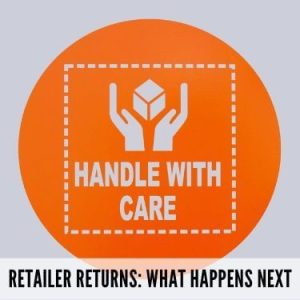
After a customer returns a product, the company must decide what to do with it. The quality of the item and the reason for being returned are the most important factors to consider when deciding where the item should go. Depending on what happens to it, a company could reclaim most or even all of the value of the item with the right strategy.
Sometimes, customers return items that don’t have anything wrong with them. Maybe they decided they wanted a different color instead, or it was a gift they received and didn’t really want. Just because this customer didn’t want the item doesn’t mean someone else wouldn’t like it.
When a product is returned in like-new condition, there is no reason to not simply sell the product again to a different customer. Retailers can place the item back on shelves, while eCommerce businesses can add the item back into their regular inventory.
Receiving returns with nothing wrong with them is the best-case scenario for businesses because it allows them to reclaim nearly the entire value of the product. Although it takes time to process the return, it can still be sold again at full-price.
When a product is returned in good shape, but the packaging is damaged, retailers can do one of two things.
For one option, they could send the package back further in the supply chain to have the item repackaged, then shipped back to sell like new. Although doing this does mean that the item can be sold at full price, the cost of shipping and repackaging often makes this option unprofitable.
What is far more likely to happen is that the product will be sold as-is, but at a discount. The box would then be marked as “clearance” or “open box,” so customers know that the item inside is of the same quality as a new product, but for a cheaper price. This way, some of the value of the item can be reclaimed, without the hassle of having it repackaged and shipped around.
When a customer opens a box and finds their purchase to be broken or defective, that can be a frustrating and disappointing experience. That customer could lose faith in your company as a result of the bad experience, so it is extremely important to manage their return quickly and assist them in any way you can, to reinforce your brand’s reputation.
Once the damaged product is back in your hands, you will have to decide what to do with it. If you have the resources, you could simply refurbish the product and sell it at a discounted price, but what is more likely to happen is that the product will need to be returned to the supplier.
Depending on the circumstances and your specific supplier, you may be able to get a refund on the item if the defect was from manufacturing. However, that won’t always be the case, and sometimes it may even cost more to ship it back to the supplier than you would get from a refund. However, if you receive an entire pallet of defective goods, it would definitely be worthwhile to send the shipment back to the supplier.
Sometimes, a returned product is damaged so badly that it cannot be resold no matter what. If this is the case, you may still be able to get some value out of the item by scrapping it and reusing or selling the parts. Even raw materials like plastics or metals could be recycled, instead of simply trashed.
There are some cases in which the product cannot be repaired, recycled, or even sold as scrap. In this case, the only thing left to do is to dispose of the item and just count it as a loss. However, sometimes disposing of an item can be more difficult than you would imagine, depending on what it is. Certain products, like batteries and electronics, are considered hazardous materials and should be treated carefully.
When you need to dispose of hazardous materials, make sure that you are being compliant with all regulations regarding the product. You could end up causing environmental harm or public health problems if you are careless about throwing away dangerous goods. You may need to reach out to a third-party company specializing in properly disposing of hazardous goods so you don’t get yourself and your business in trouble.
GET A QUOTE

For any business, managing returns can quickly turn into a time consuming and costly problem. Most smaller companies do not give their returns process much thought, and as a result, end up losing revenue, decreasing customer loyalty, and overcomplicating the entire problem. In order to stay ahead of competitors, minimize losses, and offer your customers the best experience possible, you should take the time to optimize your reverse logistics strategy.
One of the first things you should do to optimize your reverse logistics strategy is to definitively decide what to do with the products that get returned. If you only have one warehouse, it is easy to designate one space specifically for returns to keep them away from regular merchandise. However, if you own multiple warehouses in different locations, it can be a little bit more of a challenge. Most larger retailers will choose one warehouse to consolidate returns, even if that means shipping the returns over a longer distance.
Once you have a place to keep your returned merchandise, you must have a policy for dealing with it after it is all in the same place. In order to be effective, returns should be processed and sorted quickly, but it is also important to ensure the products are being handled appropriately. This is especially true if your products have hazardous components, like electronic parts or batteries. Some larger retail chains hire returns managers, whose only job would be to oversee the proper treatment and processing of returned merchandise.
When shipping returned products back to warehouses or out for repair, it is extremely important to ensure that the product does not incur additional damage in transport. Make sure that all products are secured properly for shipment, whether you have to send a single cell phone, or an entire pallet of porcelain bowls. With that said, however, you should always try to send large quantities of items at one time, otherwise the shipping costs could get expensive.
If you simply do not have the resources to manage your own retail returns process, there are third-party companies that can help you organize, manage, refurbish, and dispose of returned merchandise.
The most important thing to understand about crafting a reverse logistics strategy is that there is no such thing as a perfect strategy. You need to find the plan that works for you, and it’s likely going to be different from what all your competitors are doing. Each business is unique and requires a reverse logistics strategy tailored to fit with the way it operates.
GET A QUOTE
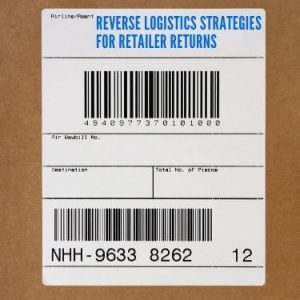
With the growth of online sales and the shift in consumer expectations, it is now more important than ever to have a streamlined reverse logistics strategy. Consumers today have come to expect excellent customer service in every situation, and if you fail to meet those expectations, your customers will move on to your competitors. If you want to get ahead of the game, you’re going to need a really strong strategy.
Your overall strategy is really comprised of many different factors working together to support the whole reverse logistics framework. There are many different strategies you could choose to implement, but it depends on the kind of company you run, who your customer base is, and the volume of returns you expect to see.
Here are a few suggestions to keep in mind when formulating your own returns strategy:
If you’ve already implemented a reverse logistics strategy for managing returns, but you aren’t seeing the kind of streamlining affect you were hoping for, it can be pretty disheartening. It could be that your standards are too high, but it is far more likely that your strategy just needs a little tweaking. With a few adjustments, your strategy could end up giving you a competitive edge over the competition.
The best place to start looking for places to make improvements is where you get the products from. When you were originally comparing suppliers, you were probably mostly concerned with the value and quality that they offered. However, you should take the time now to examine your supplier’s return policy. How easy would it be for you to return defective merchandise? Would your customers be able to ship directly to the supplier to cut shipping costs?
Take the time to examine your supplier’s policies again, and try to renegotiate a more streamlined solution if you feel that improvements could be made with the agreement. In order to streamline the reverse logistics process, the entire supply chain needs to be running smoothly.
It is an unfortunate fact that transportation costs are on the rise. Retailers that sell large or bulky items, like furniture, face even higher costs. If you want to reduce spending in the supply chain, the first thing you should look for is a way to restructure your transportation services.
First, look at the company responsible for moving your freight. For most small- to average-sized retailers, transportation has to be handled by another company, like a carrier or logistics company. Take a look at the company responsible for moving your merchandise, and compare the costs with other similar companies to make sure you’re getting the best deal.
To further cut costs, see if you can arrange to load returns onto the same truck that delivered the regular merchandise. By using the same truck, which would likely be driving back the way it came anyway, you could get a good discount on shipping returns back to your warehouse.
In order to manage returns successfully, you need to find a balance between pleasing the customer and protecting your business. Take a look at your strategy for accepting returns in the first place, and try to determine if that strategy is the best for you.
Some companies, like Kohls, will accept almost all returns with no questions asked, while companies like Amazon may shut down a customer’s account if they make too many returns. Some companies only accept returns under special circumstances. Analyze your return data to determine what the best policy would be for your products and your company.
In order to be successful in business, not just with returns, you’re going to need to collect, sort, and maintain as much data as you can. For returns, you should collect data on your customers, and how often they purchase and return things. You should also track the kinds of products that get returned most frequently, and under what circumstances. Track everything that can be tracked with data, and always keep it organized for easy reference and analysis.
Once you have your data, it is important to actually use it. Too many companies do not know what to do with all the data they collect, so it doesn’t do enough to help them. Make sure that you understand your data, and frequently reference it whenever you need to make business decisions. The data can clue you in to problems with specific customers, with manufacturing, with a specific product, and even how the returns process functions as a whole.

Even if your returns strategy works well for you, you may still end up getting overwhelmed when the holiday returns start flooding in. Your returns process may work like a well-oiled machine, but once people start returning their unwanted gifts in droves back to your stores and warehouses, your entire process can come to a halt.
The truth of the matter is that holiday returns are always going to be frustrating. However, if you plan well in advance, your business can be prepared to handle the volume of returns without impacting normal operation or costing an absurd amount of money.
The first thing you should do is to start training your team on how to handle holiday returns, and do this before the holidays begin. Things can get overwhelming fast if your employees don’t know exactly what to do with each return. If need be, select one or two people to be solely dedicated to managing returns until the post-holiday returns frenzy settles down.
As with most returns, it is important to process and sort returned merchandise back into the retail sales cycle as quickly as possible. However, when dealing with the post-holiday season, managing returned merchandise on top of the increased holiday sales and returns can be too daunting of a task. And that’s okay.
If you’re too understaffed or unprepared to sort through the returned merchandise, it isn’t always imperative to get those products back on the shelves immediately. You can set aside any products that get returned to deal with later, so you can continue to offer the best service to your customers. After the holidays are over, you can begin sorting through the returned gifts when you have more time and resources to spare.
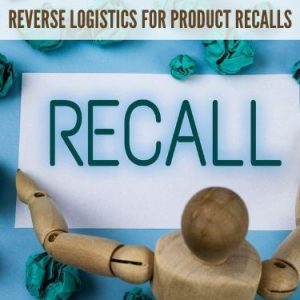
When the Consumer Product Safety Commission (CPSC) dictates that one of your products should be recalled, it can be a nightmare to deal with. In addition to legal issues and problems within your supply chain, you also somehow need to manage the collection of all the recalled products.
Once your customers have been notified of a recall, you need to be ready to receive the products they send back. Not only that, you would likely need to manage refunding customers for the product or sending replacements out on a large-scale. This can put tremendous strain on your supply chain, and many times, companies will cease normal operation until the recall has been dealt with.
In order to make sure things go smoothly, you will need to make sure that everyone in the supply chain can communicate freely with one another. You will have to inform your transport company about what will be needed from them. Additionally, you will need to ensure your warehouses are prepared to store the products, and potentially organize the transportation back to your supplier. You may also need to work out a strategy for appropriately disposing of the recalled products, if they cannot be made compliant.
GET A QUOTE

Having an effective reverse logistics strategy for managing retail returns comes with huge benefits. Even when the benefits aren’t obvious, they can still have high-level impacts on the success of your entire operation.
With a carefully crafted returns strategy, you could see benefits like:
With all those incredible benefits, it can be difficult to believe that some companies would choose to ignore their reverse logistics plan. Get ahead of your competition by improving your returns management process, to take advantage of those potential benefits.
Working with a 3PL warehouse partner like R+L Global Logistics can help you manage the reverse logistics process for retailer returns. Our staff is experienced in managing returns and can help with a number of value-added services.
Reverse logistics services available through R+L Global Logistics include:
For more information on how R+L Global Logistics can help you manage your retailer returns through reverse logistics, give us a call or reach out to us online.
GET A QUOTE
